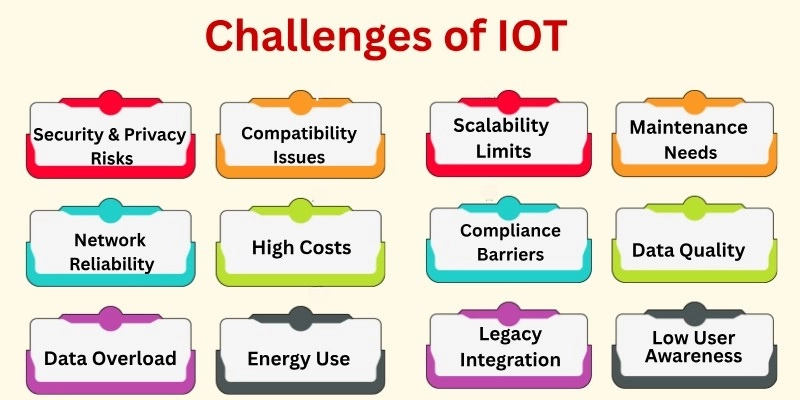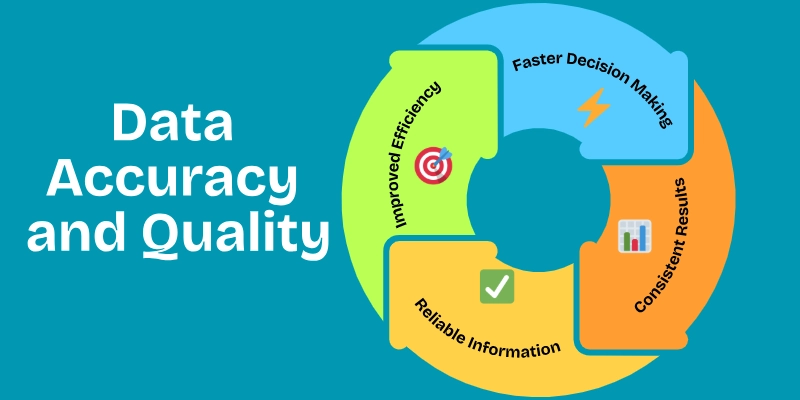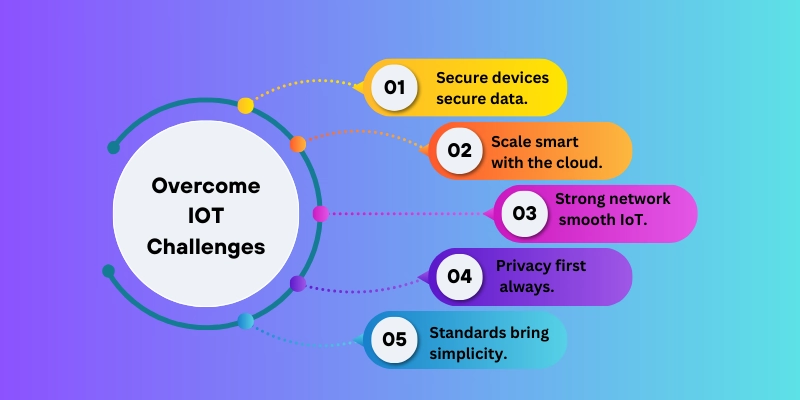Top Challenges of IoT and How to Overcome Them (Beginner’s Guide)
Published: 31 Aug 2025
The Internet of Things (IoT) has changed our world, connecting billions of devices from smart homes to industrial systems. But when IoT promises to play, efficiency, and smarter, it also faces serious obstacles. Have you ever wondered why your smart thing is unable to connect, or why experts warn of IoT security? This disappointment highlights the biggest Challenges of IoT, ranging from privacy risks, data overload, and compatibility issues to security threats, high maintenance costs, and incredible connections.
In short, there is a set of complex problems behind the magic of the affiliated units, which requires real solutions.
🌐 Challenges of IoT
The Internet of Things brings great opportunities, but it also faces many challenges that affect its growth and adoption. Here is the list of all Challenges of IoT.

- Security and Privacy Risks
- Data Overload and Management
- Compatibility and Standardization Issues
- High Implementation Costs
- Scalability Limitations
- Network Reliability Concerns
- Energy and Battery Consumption
- Data Accuracy and Quality
- Regulatory and Compliance Barriers
- Lack of User Awareness and Skills
- Integration with Legacy Systems
- Maintenance and Updates
- Limited Bandwidth Availability
- Device Longevity and Durability
- Ethical and Safety Concerns
Let’s explain these Challenges of IOT in detail one by one.
1. Data Overload and Management
IoT devices produce massive amounts of data every second, and handling it isn’t as easy as it sounds.
- Huge volumes of structured and unstructured data pile up quickly.
- Storing this data, whether on the cloud or locally, is expensive.
- Processing everything in real-time becomes complicated.
- Important insights often get buried in the noise.
- Separating useful data from irrelevant information is tough.
- Backup and recovery take a lot of planning.
- Businesses need advanced analytics and AI to make sense of it.
- Running big data infrastructure costs a fortune.
2. Compatibility and Standardization Issues
Not all IoT devices speak the same “language,” which makes them difficult to connect.
- Devices run on different communication protocols.
- Hardware and software often don’t align.
- Vendors limit interoperability between brands.
- The ecosystem feels fragmented instead of unified.
- Industry-wide standards are still lacking.
- Multi-brand device setups become tricky.
- Adoption slows down due to these inconsistencies.
- Businesses spend more on custom integrations.
3. High Implementation Costs
IoT isn’t cheap; it demands heavy upfront investment and ongoing expenses.
- Buying smart sensors and devices costs a lot.
- Cloud storage and data processing fees add up.
- Strong network infrastructure requires upgrades.
- Software licenses can become a recurring expense.
- Skilled professionals are expensive to hire.
- Regular updates and upgrades increase costs.
- Extra investment is needed for strong security.
- Returns on investment often take years to appear.
4. Scalability Limitations
As IoT grows, scaling systems smoothly becomes a real challenge.
- More devices lead to network congestion.
- Managing large device fleets gets complicated.
- Infrastructure upgrades are costly.
- Performance drops as systems expand.
- Legacy networks don’t scale well.
- Cloud service costs shoot up with growth.
- Real-time processing slows under heavy loads.
- Big deployments make integration harder.
5. Network Reliability Concerns
IoT heavily depends on a strong internet, and weak connections can ruin the experience.
- Poor connectivity causes device downtime.
- High latency is common in remote areas.
- Devices rely on an always-on internet.
- Network failures can cause big disruptions.
- Critical services like healthcare may face risks.
- Supporting millions of devices strains the network.
- Signal interference lowers performance.
- Offline functionality is often limited.
6. Energy and Battery Consumption
Many IoT devices run on batteries, and keeping them powered is a big issue.
- Frequent battery replacements are needed.
- Sensors often have a short lifespan.
- Maintenance costs rise with power needs.
- Small devices struggle with energy harvesting.
- Charging downtime affects performance.
- Environmental concerns grow with battery waste.
- Power-saving modes limit functionality.
- Energy-efficient designs come with higher costs.
7. Data Accuracy and Quality
IoT is only as useful as the data it provides, but that data isn’t always reliable.

- Errors occur due to false or incomplete collection.
- Sensor malfunctions cause inaccurate results.
- Environmental factors affect readings.
- Real-time validation is difficult.
- Data quality often varies between devices.
- Verification processes are lacking.
- Poorly calibrated sensors give wrong insights.
- Low-quality data leads to misleading conclusions.
8. Regulatory and Compliance Barriers
IoT faces strict legal requirements that make adoption harder.
- Data protection laws like GDPR must be followed.
- Regional laws differ, adding complexity.
- Cross-border data sharing is restricted.
- Non-compliance can result in heavy fines.
- Rules change frequently and need constant updates.
- Compliance management raises costs.
- Device certifications take time and money.
- Regulations can delay new product launches.
9. Lack of User Awareness and Skills
Many users and businesses struggle to understand IoT systems properly.
- Limited technical knowledge slows adoption.
- Best practices are rarely followed.
- Training opportunities are lacking.
- Devices often get mismanaged.
- Security updates are ignored.
- Many fail to unlock IoT’s full potential.
- Over-reliance on third parties creates risks.
- Fear of complexity discourages adoption.
10. Integration with Legacy Systems
Old systems don’t always blend well with modern IoT solutions.
- Outdated infrastructure struggles to support IoT.
- Upgrading old systems costs a lot.
- Older software often lacks support.
- Data synchronization is difficult.
- Integrations can disrupt normal business.
- Middleware is often required to bridge gaps.
- Projects take longer than expected.
- The risk of losing important legacy data exists.
11. Security and Privacy Risks
IoT devices are prime targets for hackers, making security a top concern.
- Many devices still use weak default passwords.
- Encryption is often limited or missing.
- Data breaches are becoming more common.
- Unauthorized access to devices poses risks.
- Security patches aren’t rolled out regularly.
- Malware can spread across IoT networks.
- Personal privacy is often compromised.
- Hacked devices can cause real-world harm.
12. Maintenance and Updates
IoT systems need ongoing attention to stay functional and secure.
- Devices require frequent firmware updates.
- Maintenance becomes costly over time.
- Remote devices are harder to update.
- Updates often cause temporary downtime.
- New upgrades can create compatibility issues.
- Skilled teams are needed to handle upkeep.
- Outdated devices turn into security risks.
- IT teams face a growing workload.
13. Limited Bandwidth Availability
As IoT grows, existing networks struggle to keep up.
- Connected devices generate huge traffic.
- Urban areas face severe network congestion.
- Rural areas suffer from low bandwidth.
- IoT applications run slower under pressure.
- Expanding bandwidth is costly.
- Digital services compete for the same resources.
- Overloaded networks risk losing data.
- Real-time apps face high latency.
14. Device Longevity and Durability
IoT devices don’t always last as long as expected.
- Harsh conditions damage devices quickly.
- Many sensors wear out after a short time.
- Physical damage and wear are common.
- Weather and corrosion shorten lifespans.
- Replacements are required more often.
- Growing e-waste becomes an issue.
- Replacement costs are high.
- Device failures lead to downtime.
15. Ethical and Safety Concerns
Beyond technology, IoT also raises big ethical and social questions.
- Worries about surveillance and constant tracking.
- Concerns about how companies use collected data.
- Risks of data misuse for profit or control.
- Safety issues in autonomous IoT systems.
- Lack of accountability when failures happen.
- Automation may lead to job losses.
- AI-driven IoT systems can carry bias.
- Unequal access creates social divides.
How to Overcome IoT Challenges
Overcoming the challenges of IoT is possible with these practical and easy-to-follow tips:

- Buy IoT products only from reliable and reliable brands.
- Always use a safe and encrypted internet connection.
- Enable two-factor authentication where possible.
- Limit access to the device only for reliable users.
- Monitor unit activity regularly for abnormal behavior.
- Use a firewall and safety equipment to add extra safety.
- Use strong and unique passwords for all IoT devices.
- Keep the devices updated with the latest software and security updates.
Conclusion
The Challenges of IOT are real, from security risk and high costs to compatibility problems and data overload, but do not hold them back. By taking small but consistent steps, for example, updating equipment, using reliable brands, and securing your network, you can make these challenges opportunities for development and innovation. Always be careful with disadvantages such as neglect of updating or ignoring data privacy, as they can cause major problems in the long run. Remember that the Challenges of IoT are not obstacles, but push the stones forward, so be motivated, search for IoT for a smart and more connected future, and build and use IoT.
FAQs
Here are some important FAQs related to the Challenges of IOT. Let’s get started.
Beginners often struggle with security risks, data privacy concerns, and understanding how devices connect to the internet. These are the first hurdles most users face.
Use strong passwords, regularly update device software, and connect through a secure Wi-Fi network to reduce risks.
IoT devices generate massive amounts of data, and beginners may find it hard to store, manage, or analyze this information effectively.
Yes, high implementation costs are a challenge of IoT, especially for businesses. For beginners, starting small with trusted, affordable devices is a good step.
Experts use standardized protocols and middleware solutions to ensure devices from different brands can communicate with each other.
Unauthorized access and data breaches are major concerns. Even experts continuously update systems and use advanced encryption to minimize risks.
Integration with legacy systems is tough, but experts often use APIs, cloud platforms, or IoT gateways to bridge the gap.
Common mistakes include ignoring updates, using default passwords, and not checking brand credibility. These can make devices vulnerable to attacks.
The five major challenges are security risks, data overload, compatibility issues, high implementation cost, and scalability limitations.

- Be Respectful
- Stay Relevant
- Stay Positive
- True Feedback
- Encourage Discussion
- Avoid Spamming
- No Fake News
- Don't Copy-Paste
- No Personal Attacks

- Be Respectful
- Stay Relevant
- Stay Positive
- True Feedback
- Encourage Discussion
- Avoid Spamming
- No Fake News
- Don't Copy-Paste
- No Personal Attacks





